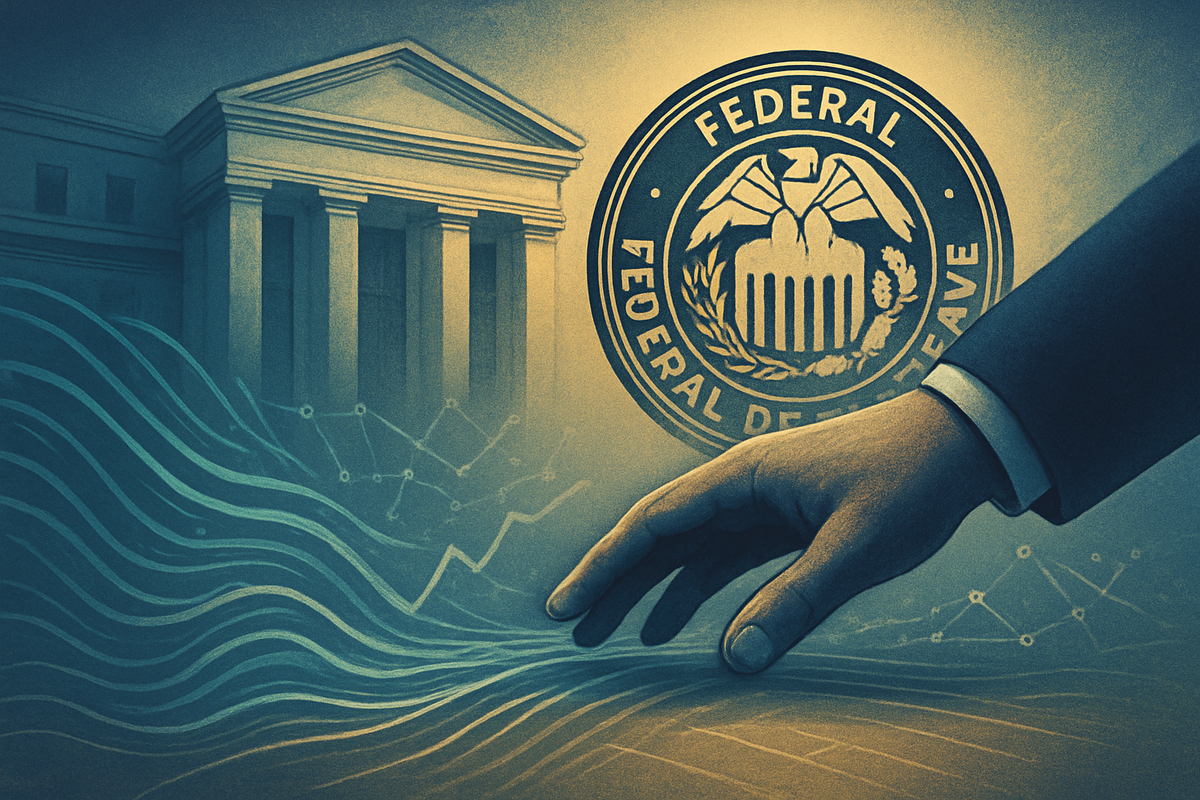
In a significant move to avert a potential financial crisis, the Federal Reserve announced in October 2025 its decision to halt its three-year Quantitative Tightening (QT) program and cut interest rates. This decisive action comes amidst growing concerns over tightening liquidity in money markets and recent market strains, signaling that the central bank is actively working to ease pressure on banks and ensure the smooth functioning of the financial system. The abrupt policy pivot underscores the Fed's commitment to financial stability, but also raises questions about the underlying vulnerabilities within the U.S. economy and the delicate balance required to manage both inflation and liquidity.
The market's anticipation of this policy shift had been building, as indicators pointed to increasing stress in short-term funding markets. The Fed's intervention is a direct response to these pressures, aiming to inject much-needed cash flow into the banking system and prevent a broader contagion that could destabilize public companies and the wider economy. While the immediate reaction has been one of cautious relief, the long-term implications of this emergency intervention will undoubtedly shape market sentiment and investment strategies in the coming months.
A Proactive Stance Amidst Mounting Market Strains
The Federal Reserve's October 2025 decision to cease Quantitative Tightening (QT) and reduce interest rates was a direct response to what it identified as "recent market strains and tightening money market liquidity." This intervention follows a period of increasing concern within financial circles, where various indicators, including elevated repo rates and increased reliance on emergency funding tools by some bank lenders, signaled a brewing liquidity crunch. The Fed's three-year QT program, which involved shrinking its balance sheet by allowing matured bonds to roll off without reinvestment, had been steadily drawing reserves out of the banking system. While intended to normalize monetary policy and combat inflation, the program's continuation evidently pushed the financial system closer to a critical threshold of reserve scarcity, reminiscent of past liquidity events.
This is not the first time the Federal Reserve has had to step in to address liquidity issues. The September 2019 repo market crisis, where overnight lending rates spiked unexpectedly due to a shortage of reserves, forced the Fed to intervene with immediate liquidity injections and reverse its balance sheet reduction. Similarly, the onset of the COVID-19 pandemic in 2020 saw the Fed unleash an unprecedented array of emergency lending facilities to prevent a global dollar liquidity squeeze. More recently, the 2023 United States banking crisis, which saw the failures of Silicon Valley Bank (NASDAQ: SIVB) and Signature Bank (NASDAQ: SIBN), highlighted vulnerabilities stemming from rising interest rates and unrealized losses on bank bond portfolios, prompting the establishment of the Bank Term Funding Program (BTFP) to provide extraordinary liquidity. These historical precedents undoubtedly informed the Fed's proactive stance in October 2025, demonstrating a heightened sensitivity to the potential for systemic risk when liquidity tightens. The key players involved in this decision were the Federal Open Market Committee (FOMC) members, who collectively assessed the economic data and market conditions to determine the appropriate policy response. Initial market reactions have been mixed, with some relief over the Fed's intervention, but also underlying apprehension about the health of the financial system that necessitated such a significant pivot.
Navigating the Ripple Effects: Potential Winners and Losers
The Federal Reserve's pivot to halt QT and cut interest rates in response to liquidity concerns will undoubtedly create a new landscape of winners and losers across various sectors of the economy. Banks and financial institutions are likely to be among the primary beneficiaries. The cessation of QT means an end to the shrinking of the Fed's balance sheet, which had been draining reserves from the banking system. This, coupled with interest rate cuts, should ease funding costs and alleviate pressure on banks' balance sheets, potentially improving their net interest margins and overall profitability. Regional banks, in particular, which might have been more susceptible to tightening liquidity, could see significant relief. Companies like JPMorgan Chase & Co. (NYSE: JPM), Bank of America Corp. (NYSE: BAC), and Wells Fargo & Company (NYSE: WFC) could see improved lending conditions and reduced funding stress.
Conversely, some sectors might face headwinds or see their previous advantages diminish. Companies that thrived in a higher interest rate environment due to their strong cash positions or ability to generate high returns on their reserves might find their relative advantage reduced. However, given the context of a liquidity crisis, the broader relief provided by the Fed's actions is likely to be viewed positively across most equity markets. Highly leveraged companies and sectors that are sensitive to borrowing costs, such as real estate developers and capital-intensive industries, stand to gain significantly from lower interest rates. Reduced debt servicing costs could improve their profitability and investment prospects. Similarly, growth stocks, particularly in the technology sector, which often rely on future earnings potential and are sensitive to discount rates, could see a boost as lower rates make their future cash flows more valuable. Companies like Apple Inc. (NASDAQ: AAPL) or Microsoft Corp. (NASDAQ: MSFT), while less directly impacted by funding costs, benefit from a more stable and supportive macroeconomic environment. Bond markets are also likely to see a rally, as lower rates increase the value of existing bonds, benefiting investors holding fixed-income assets. The challenge for investors will be identifying companies that can leverage the improved liquidity conditions and lower cost of capital to drive sustainable growth, while avoiding those that might be exposed to lingering systemic vulnerabilities despite the Fed's intervention.
Broader Implications: A Shift in Monetary Strategy and Financial Stability
The Federal Reserve's decision in October 2025 to halt Quantitative Tightening and cut interest rates in response to tightening liquidity marks a pivotal moment in contemporary monetary policy, reflecting a significant recalibration of its approach to financial stability. This event underscores how deeply embedded the "ample reserves" system has become, where the Fed must actively manage the quantity of reserves to prevent market dysfunction. The rapid policy reversal highlights the inherent tension between combating inflation through balance sheet reduction and maintaining sufficient liquidity to avert systemic risk. This situation fits into a broader trend where central banks globally are grappling with the aftermath of prolonged periods of unconventional monetary policies, struggling to unwind their expanded balance sheets without triggering unintended consequences.
The potential ripple effects extend far beyond immediate market reactions. For competitors and partners, a more stable financial environment, thanks to eased liquidity, could reduce counterparty risk and foster more robust interbank lending. However, the necessity of such an intervention could also prompt increased scrutiny from regulators regarding banks' liquidity buffers and risk management practices, particularly for those institutions that showed signs of stress. There could be renewed calls for adjustments to regulatory frameworks, such as the "Tailoring rules" that were criticized for potentially allowing some banks to operate with reduced liquidity buffers. Historically, central bank interventions of this magnitude, especially outside of declared recessions, are rare and typically signal deep-seated vulnerabilities. Comparisons can be drawn to the Fed's actions during the 2008 financial crisis and the 2020 pandemic, although the current situation, necessitating a pivot during a period of balance sheet reduction, suggests a unique challenge in managing the delicate interplay of interest rates, reserves, and market confidence. This event reinforces the Fed's role not just as an inflation combatant but as the ultimate guarantor of financial stability, willing to adjust its stance aggressively when systemic risks emerge.
What Comes Next: Navigating a New Monetary Landscape
The Federal Reserve's decisive action in October 2025 to halt QT and cut interest rates ushers in a new phase for financial markets and the broader U.S. economy. In the short term, markets are likely to experience a period of adjustment as participants digest the implications of this significant policy shift. We can anticipate continued volatility as investors re-evaluate asset prices in light of lower interest rates and increased liquidity. Bond yields are expected to fall further, potentially leading to a rally in fixed-income markets, while equities might see a boost from improved corporate borrowing conditions and a reduced risk of a liquidity-induced downturn. Companies that were struggling with high borrowing costs or limited access to capital may find renewed opportunities for expansion and investment. However, the underlying concerns about the health of the financial system that necessitated the Fed's intervention will remain, prompting ongoing vigilance from market participants.
Looking further ahead, the long-term possibilities are multifaceted. The Fed's pivot could signal a more accommodative monetary policy stance for an extended period, potentially leading to a lower-for-longer interest rate environment than previously anticipated. This could have significant implications for savers, pension funds, and the housing market. Strategic pivots will be required across various sectors; financial institutions will need to adapt to a potentially flatter yield curve, while corporations may need to re-evaluate their capital allocation strategies given the cheaper cost of debt. Market opportunities may emerge in areas sensitive to interest rates, such as real estate investment trusts (REITs) and utilities, or in companies with robust growth prospects that can capitalize on improved funding conditions. Conversely, challenges may arise for sectors that had benefited from the previous tightening cycle. Potential scenarios range from a successful stabilization and gradual recovery of market confidence, leading to sustained economic growth, to a more prolonged period of uncertainty if underlying systemic issues persist despite the Fed's intervention. The effectiveness of this emergency measure will largely depend on whether it truly addresses the root causes of the liquidity strains or merely postpones a deeper reckoning.
Wrap-Up: A Resilient Fed and the Path Forward
The Federal Reserve's swift and substantial policy reversal in October 2025 – halting Quantitative Tightening and cutting interest rates – serves as a critical juncture for the U.S. financial system. The key takeaway from this event is the Fed's unwavering commitment to financial stability, demonstrating its willingness to pivot aggressively when faced with tightening money market liquidity and potential systemic risks. This action underscores the inherent complexities of managing a modern economy, where the delicate balance between controlling inflation and ensuring adequate liquidity is paramount. While the immediate objective is to ease pressure on banks and prevent a broader crisis, the necessity of such an emergency intervention highlights persistent vulnerabilities within the financial landscape, some of which trace back to the ample reserves system and the unwinding of post-crisis monetary policies.
Moving forward, the market will likely operate under a renewed understanding of the Federal Reserve's reactive capacity. Investors should assess companies not only on their fundamentals but also on their sensitivity to interest rate changes and access to capital. The cessation of QT and rate cuts are generally supportive for asset prices and economic activity in the short term, but the underlying message of market strain should not be overlooked. Long-term, the lasting impact will depend on whether this intervention provides a temporary fix or allows for a more fundamental rebalancing of liquidity in the banking system. Investors should closely watch for any further communications from the Federal Reserve regarding its balance sheet policy and future interest rate path, as well as monitor key indicators of money market health, such as repo rates and bank reserve levels. The coming months will be crucial in determining whether the Fed's October 2025 pivot successfully steered the economy away from a more significant liquidity crisis, or if deeper structural issues will necessitate further unconventional measures.
This content is intended for informational purposes only and is not financial advice






